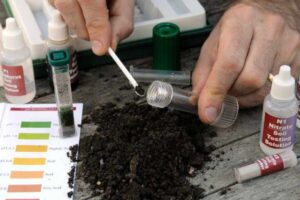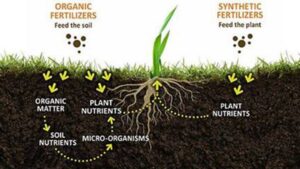Table of Contents
 Hydrangeas are beautiful flowering shrubs for their stunning blooms. If you want to achieve healthy and vibrant hydrangeas, you should ensure the right soil conditions. For some hydrangea varieties, you may need neutral to alkaline soil. Others prefer an acidic environment.
Hydrangeas are beautiful flowering shrubs for their stunning blooms. If you want to achieve healthy and vibrant hydrangeas, you should ensure the right soil conditions. For some hydrangea varieties, you may need neutral to alkaline soil. Others prefer an acidic environment.
If you are unhappy with the color of hydrangeas, you can make the soil more acidic. For this purpose, test the pH level, incorporate peat moss and add organic matter. Sometimes you can use sulfur to make the soil acidic for hydrangeas. Here are some tips to make the soil acidic for hydrangeas:
Test the pH Level of the Soil

In the first step, test the pH level of your soil. It will help you determine its acidity. See below how to do it:
- Purchase a kit to test soil from a garden store. Various kits are available, including liquid test kits, pH test strips and pH meters.
- Collect soil samples using a garden spade or trowel from different garden areas. You can take samples from different locations where you want to grow hydrangeas. It will be a good representation of overall soil pH.
- Prepare your soil samples by removing debris like plant roots or rocks from the soil. If you see large clumps, break them and mix the soil well.
- Follow the instructions of the testing kit and perform a test. You will add soil samples to a test tube or container. Now add a testing strip or reagent according to the instructions.
- After completing the test, compare the reading or color obtained with the kit. The range of the pH scale goes from 0 to 14. Remember, 7 represents neutral pH. If the pH of the soil is below, it represents its acidic nature. Your soil is alkaline if your pH reading is over 7. Hydrangeas need acidic soil. Try to maintain the soil’s pH level between 5.0 and 5.5.
Regularly test the pH level of your soil. It helps you monitor and maintain the acidity required for healthy hydrangeas.
Add Organic Matter to Soil

After testing pH, add organic matter if you want to acidify the soil. These may include coffee grounds, peat moss, oak leaves, pine needles, compost and well-rotted manure. Peat moss is useful to acidify soil due to its high acidity content. Here are some easy steps to follow to add organic matter to soil:
- Before adding organic matter, prepare the soil by removing debris, rocks and weeds. Use a garden fork or tiller to loosen the soil and improve its texture. It will promote better incorporation of organic matter.
- Apply a layer of organic matter around the base of the hydrangea. Make sure to cover the root zone. If you have compost or well-rotted manure, spread it in a layer about 2 to 3 inches thick. You should apply a thick layer for oak leaves or pine needs to compensate for their slow decomposition rate.
- Gently mix the organic matter into the top few inches of soil around the hydrangea plant with a shovel or garden fork. You should be careful while mixing because rough handling can damage the plant or roots. Alternatively, you can apply organic matter on the top of the soil. Treat it as a mulch layer, and don’t mix it in.
- Once you add organic matter, it is time to water the soil thoroughly. Now let it settle and promote decomposition. Sufficient moisture will help gradually release acidic compounds from the organic matter in the soil.
- Regularly test the soil’s pH level to monitor the effectiveness of the organic matter. It will help you acidify the soil. Retest annually or as needed to maintain the desired level of acidity.
Grow Beautiful Blue Hydrangea
To grow blue hydrangea flowers, change the acidic condition of the soil. Here is what you can do:
In the first step, choose the right hydrangea varieties that can produce blue flowers. The most common species to produce blue blooms are Macrophylla hydrangea. It is also known as mophead or bigleaf hydrangeas.
Test the soil for pH level. If the pH ranges from 5.0 to 5.5, your soil is ready to grow blue flowers. For soil with higher pH, you should acidify it by adding organic matter and peat moss.
Add aluminum sulfate to the soil: If you want to improve the blue color of blooms, you can add aluminum sulfate to the soil. It is a soil additive to amplify the blue color of hydrangea flowers. Make sure to follow the instructions available on the package of aluminum sulfate. Typically, you should dissolve the aluminum sulfate in water and apply it around the base of the hydrangea plant. Avoid over-applying because excessive aluminum can harm the plant.
You can mulch the soil with pine needles or coffee grounds. It will contribute to lower the soil pH over time. Spread a layer of pine needles or coffee grounds around the base of your plant as a natural mulch. As these materials break down, they release acid in the soil to promote blue flower coloration.
Hydrangeas need moist soil conditions to thrive. So, regularly water your hydrangea plants to keep the soil consistently moist. But avoid water logging because it can damage your plant. Sufficient moisture helps plants take up important nutrients and grow vibrant blue blooms.
You should not use high-phosphorus fertilizers. These can inhibit the availability of aluminum. Remember, aluminum is important for the blue color of hydrangea blooms. Excessive phosphorus can impact the blue color of blooms. Make sure to opt for fertilizers with a balanced ratio of nutrients. Or you can choose fertilizers produced for acid-loving plants.
If your hydrangea is not showing good results, learn how to revive hydrangea.
Conclusion
To grow hydrangea and keep them healthy, focus on the pH level of your soil. In this article, you learn how to make acidic soil for hydrangeas. You should test the soil pH level and make adjustments according to the requirements of your hydrangea variety.
After making adjustments, you should regularly monitor the soil’s pH level. To keep hydrangeas healthy, you should maintain the ideal pH level. Retest the soil as needed to maintain the desired acidity.
Remember, it may take time to achieve blue hydrangea blooms. So, wait patiently because changing the soil pH might take 1 – 2 seasons. Moreover, the genetics of hydrangea varieties and light exposure can influence the shade of blue in the blooms.
